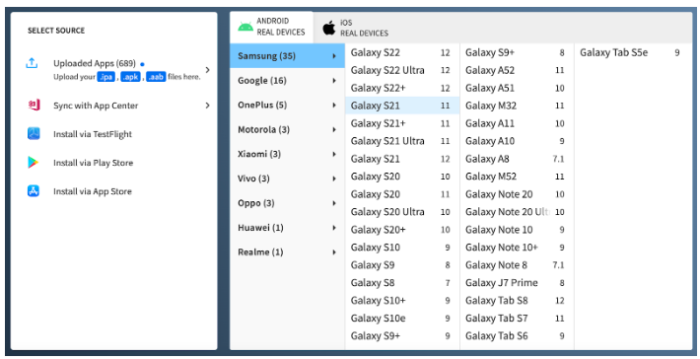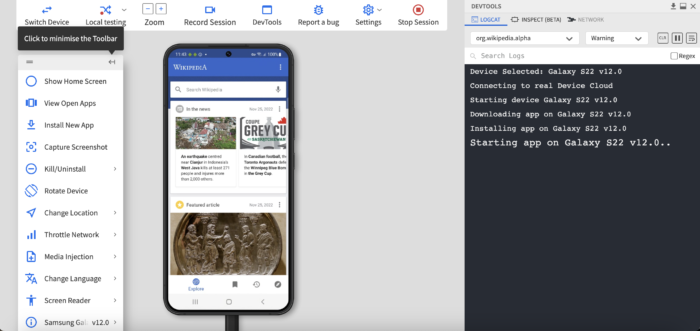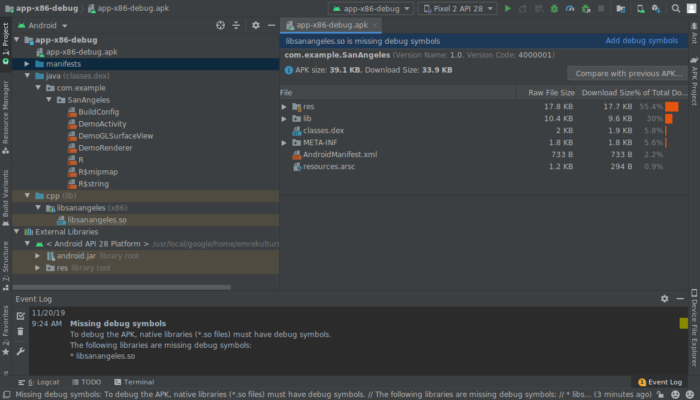APK files are the most common format used for distributing and installing apps on Android devices.
Overview
What is an APK file?
APK stands for “Android Package Kit” and is the file format used to distribute and install apps on Android OS. It contains all the essential components—like code, resources, and assets—that an app needs to run on the Android operating system.
How do APK files work?
- APK files are compressed archives that contain the app’s code, resources, and other important information such as dex files, assets, etc.
- When an APK is installed, Android unpacks the contents, extracts necessary files, and places them in the appropriate system folders.
- The Android OS then reads the app’s manifest to understand its structure, permissions, and components to run the app smoothly.
How to test APK files?
- Using BrowserStack: Test the APK on real Android devices remotely via BrowserStack’s App Live and ensure compatibility across various devices.
- Using Android Studio Emulator: Run the APK on a virtual Android device within Android Studio to test its functionality.
This guide will explain what an APK file is, its uses, working principles, and how to create and test one.
What is an APK File?
An APK (Android Package Kit) is the standard file format used to install apps on Android. It acts like a zip archive that bundles all components needed for an app, including code, resources, assets, and the manifest file. Android reads this package to install, run, and manage the app on a device.
Also Read: How to test .aab file on Android device
What are APK Files Used For?
One core use of APK files is allowing users to install apps on their Android phones. Like APPX files in Windows 10 or package files on other platforms, APK files contain instructions to install the application and information about the package.
When a user installs an application from Google Play Store, the platform automatically installs the APK and acts as a package manager.
But because of the open nature of the ecosystem, developers also upload APKs on multiple other platforms, such as APKPure and APKMirror. The user can also download the APK version and manually install the application using the package installer available on the Android device.
Components of APK File
An APK file is a structured archive containing everything an Android device needs to install and run an app. Key components include:
- AndroidManifest.xml: This is the core configuration file. It defines the app’s package name, permissions it requires (like camera or internet), the activities and services it uses, supported Android versions, and other essential metadata.
- Classes.dex: This file contains the compiled code written in Java or Kotlin, converted into Dalvik bytecode that can run on Android’s runtime environment. Most apps have at least one classes.dex, though large apps may include multiple.
- Resources.arsc: This file holds compiled resources such as strings, styles, and other XML-based content. It allows the app to load language-specific or device-specific content efficiently.
- res/: This directory contains uncompiled resources, including layout XML files, images, icons, and UI components. These are referenced by the app at runtime and compiled during the build process.
- assets/: A folder used to include raw files that the app can access at runtime, such as configuration files, fonts, HTML files, or media. Unlike res/, files in assets/ are not given resource IDs and must be accessed manually via AssetManager.
- lib/: Contains compiled native libraries in .so format for different CPU architectures like ARM or x86. These are used when the app depends on C or C++ code for performance-critical operations.
- META-INF/: It stores the app’s certificate, signature, and a manifest file used for verifying the integrity and authenticity of the APK. This ensures the app has not been tampered with after being signed.
How does APK Work
An APK file works by serving as a container for an Android app’s components, including code, resources, and manifest files. Here’s how it works:
- Download & Installation: When you download an APK, it’s transferred to your device. If it’s from an official source, Android automatically processes and installs the app. You can also manually install APKs by enabling “Install from Unknown Sources” in device settings.
- Decompression: Upon installation, the APK file is decompressed, and its contents (app code, resources, libraries) are extracted into the system.
- Execution: Android’s operating system uses the extracted files to run the app. The app’s .dex (Dalvik Executable) files are interpreted and run on the Android runtime environment.
- App Access: Once installed, the app is ready to be launched and used, and the Android system manages its interaction with the device’s hardware, software, and APIs.
How to Open and Install APK (Android Package Kit) Files?
Installing an APK file on an Android device requires a few manual steps, especially if the app isn’t from the Play Store. Here’s how to do it:
- Enable Installation from Unknown Sources: Go to Settings > Apps > Special app access > Install unknown apps. Choose the browser or file manager you’ll use, then enable Allow from this source.
- Download or Transfer the APK File: You can either download the APK directly from a trusted website using your browser or transfer it from a PC via USB, Bluetooth, or cloud storage.
- Locate the APK File: Use the Files app or any file manager to navigate to your Downloads folder or wherever the APK is stored.
- Install the APK: Tap the APK file. A prompt will appear asking if you want to install the app. Tap Install and wait for the process to finish.
- Open the App: Once installed, tap Open or find the app in your app drawer to launch it.
Risks of Downloading APKs
Installing APK files from outside the Play Store can expose your device to several risks if you’re not careful. Key risks include:
- Malware and viruses: APKs from untrusted sources can contain malicious code that steals data, tracks activity, or damages your device. Some malware runs silently in the background and is hard to detect.
- Data theft: Malicious apps can access sensitive information like contacts, messages, login credentials, and financial details without your knowledge.
- No automatic updates: Apps installed via APK won’t receive updates from the Play Store, which may leave them outdated or vulnerable to bugs and exploits.
- Permissions misuse: Some APKs request unnecessary permissions and misuse them to monitor your behavior or access private data.
- Device instability: Poorly built or incompatible APKs can crash, freeze, or slow down your device, especially if not optimized for your Android version.
Read More: 11 Reasons Why Mobile Apps Crash
- Legal and policy issues: Downloading paid or region-locked apps via APKs can violate copyright laws or platform policies and lead to account suspension or legal action.
How to Ensure APK Files Are Safe
Follow these steps to minimize the risks of installing malicious APK files.
- Download from trusted sources: Always download APK files from reputable and well-known websites or developers. The official websites and forums are safer than third-party, unverified sites.
- Use antivirus software: Scan the APK with a reliable antivirus app before installation. Some security apps can detect known malware and harmful components in APKs.
- Review app permissions: Check the permissions requested by the APK. If an app requests unnecessary or suspicious permissions, it could be a red flag.
- Read reviews and ratings: If available, check reviews or ratings on third-party APK sites. User feedback can help identify issues or confirm the app’s safety.
How to Create an APK File?
An Android app is created using Android Studio, which is the official development tool for Android. Once the code is finalized, the development team can use Android Studio to compile the developed application and put it into a container called APK.
Based on the type of APK file required, the generation process may differ. Here are the two methods to generate APK files for an application:
- Generating a debug APK file
These APK files are generated for testing purposes and can’t be uploaded to the Google Play Store for the public.
Once you build an application, you can import it into an APK file by selecting Build > Build Bundle(s)/APK(s) > Build APK(s) in the Android Studio dashboard. Refer to the image below to better understand the process.
- Generating a signed APK file
A signed APK file is necessary when you have tested your application and want to upload it to the Google Play Store for public release. The APK is secured with KeyStore credentials generated by the development team, and it also has password security. Akeystore contains cryptographic keys stored in a container. A Keystore makes it difficult to extract cryptographic keys from the device.
To create a signed APK file, select the Build option and then click Generate Signed Bundle / APK.
You must create a new KeyStore credential for the application. Add a new password and other securiy details to finalize the release version of the APK.
The APK will be created in your desired destination and ready to be uploaded to the Google Play Store for your application launch.
You can open an APK file using simple steps to access the application information.
How to Test an APK File?
Testing is the most important aspect before you publish your Android application in the public domain. Here are two ways to test an APK file.
1. Using BrowserStack
BrowserStack allows you to quickly load your dev and production apps into real Android devices to test them for performance, functionality, and user experience test.
The cloud based testing platform provides you access to real Android devices without investing in the testing infrastructure.
Here’s how simple it is to install and run your APK files on BrowserStack.
Step 1: Sign up for a free trial or purchase a tailored plan for BrowserStack App-Live.
Step 2: Access the App-Live dashboard and click on the Upload your Apps section.
Step 3: Upload the .apk file you want to test or enter the URL to retrieve the file from a public location For testing production apps, you can select the Install via Play Store option.
Step 4: Once the APK file is uploaded, you can choose the desired Android device to test the app on. It will initiate a new App-Live session and connect you to a real mobile device from the BrowserStack cloud.
Step 5: Once the session begins, the .apk file gets installed on your chosen device for testing.
Step 6: You can then test your Andriod application on the selected devices and check its user experience, functionality, etc.
Minimize the hassles of testing APK files using BrowserStack and get access to the best real device cloud ecosystem instead of choosing slow and complex simulators and emulators.
While testing, you can also record the session, debug using our powerful dev tools, log bugs directly in your bug-tracking tools, and so much more.
Also Read: Android Emulator vs Real Devices
2. Using Android Studio Emulator
Android Studio Emulator allows you to run and view test results from your IDE. You can run tests for different methods or classes across different devices. Here, Android Studio emulates the devices and allows you to test it.
However, using Android Studio for testing comes with its own set of limitations.
- Consumes too much RAM. For the best experience, you would need at least 16GB RAM.
- Emulators are generally slow.
- They are not 100% accurate.
- Cannot emulate hardware performance.
- Has issues with debugging
To overcome these challenges it is always best to test your app on a real device. But, setting up and maintaining an internal device lab is also costly. That’s when real device cloud comes into the picture. Real device cloud are real devices hosted on a cloud. By using a real device cloud, you are actually testing on a real device.
BrowserStack comes with 3500+ different combinations of real devices, browsers, and operating systems. You can easily test your .apk file in just a matter of a few minutes.
Test your .apk file on real devices now
If you would still like to test your app using Android Studio follow the below steps:
Step 1: Select Profile or debug APK on the welcome screen to start the debugging process. You can also click File > Profile or Debug APK if you have an open project in Android Studio.
Step 2: Import the APK into Android Studio and select OK.
Step 3: You can view the unpacked APK files.
Step 4: Now you can use the Android profiler to kick-start the performance testing of your application.
If your application is completely developed, it’s mandatory to test APK files in real user conditions. It can help you spot and resolve important bugs and glitches that must be fixed before public release.
Why Test APK Files on BrowserStack App Live?
Testing your APK files on BrowserStack App Live gives you access to a powerful suite of features that streamline the process and ensure your app works seamlessly across devices. Here’s why it’s a top choice:
- Real Device Cloud: Test on a wide variety of real devices, including iPhone, Samsung Galaxy, Pixel, Nexus, and more, across multiple Android and iOS versions.
- Real User Conditions: Simulate real user conditions with access to 15+ native device features like GPS, network simulation, and localization.
- Natural Gestures: Interact with your mobile app on remote devices with natural gestures like tap, scroll, zoom, swipe, and more, just as you would on a physical device.
- Dev Tools: Instantly debug your app by viewing crash reports, logs, inspecting UI elements, and using stack traces to find and fix bugs.
- Local Testing: Easily test your native and hybrid apps in internal development and staging environments.
APK vs AAB
An APK file is the standard format for distributing Android apps. It contains all the necessary files to install and run the app, including code, resources, and metadata. APKs are often directly downloaded and installed on devices. While, AAB is a more efficient and flexible format introduced by Google.
Unlike an APK, an AAB does not contain all the app’s resources and code. Instead, it contains a collection of modules that Google Play uses to generate APKs tailored to a device’s specific configuration (like, screen size, architecture, and language).
Here’s a tabular comparison to highlight the key differences:
| Feature | APK (Android Package Kit) | AAB (Android App Bundle) |
|---|---|---|
| File Size | Larger file size as it includes all resources for all device configurations. | Smaller file size; Google Play generates optimized APKs based on device configurations. |
| Distribution | Can be directly downloaded and installed from any source (Google Play or third-party). | Can only be distributed via Google Play, where APKs are generated for each device. |
| Device Optimization | No optimization for specific device configurations. | Optimized for different devices (screen size, architecture, language, etc.). |
| Installation | Directly installed on Android devices. | Cannot be installed directly; must be processed through Google Play. |
| Flexibility | Offers a one-size-fits-all app package. | More flexible; generates device-specific APKs for better efficiency. |
| Usage | Widely used for direct APK installs (e.g., from websites). | Primarily used for apps published on Google Play. |
Summary:
- APK is the traditional format, offering direct installation but at a larger size and less flexibility.
- AAB is a more modern and optimized format for Google Play, reducing app size and offering tailored APKs based on device configurations.
How to test APK files on a PC?
QAs and developers can leverage BrowserStack to test APK files on a web browser.
Following the steps listed above article, testing teams can create the most agile and accurate real device testing ecosystem remotely.
The features available on the floating toolbar can make the APK file testing process easy.
You can:
- Debug using powerful dev tools. Read more on how to get Android App Crash Logs.
- Use device rotation to check the app’s appearance in landscape and portrait mode.
- Capture screenshot
- Change languages
- Perform Geolocation Testing.
- Create poor network conditions using the Network throttler feature.
Also Read: How to test Push Notifications on Android
Conclusion
An APK (Android Package Kit) file is the standard format used to distribute and install apps on Android devices. It contains all the components needed for an Android app to function, including the manifest, compiled code, resources, and assets. Although APKs provide flexibility for app distribution and sideloading, they also come with security risks if downloaded from untrusted sources.
If you’re a developer or tester, you can use BrowserStack App Live to test APK files on real Android devices. It lets you upload and install your APK in seconds, evaluate app performance across different OS versions and screen sizes, and debug issues without needing a physical device lab.















